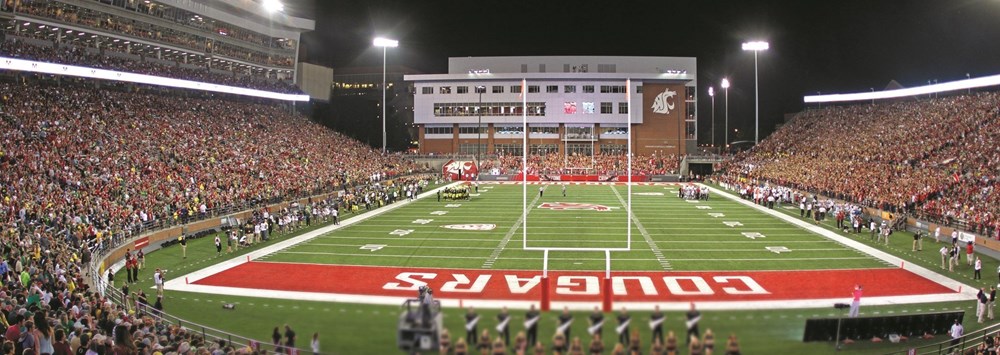Martin Stadium Information

Martin Stadium is an outdoor athletic stadium in the Pacific Northwest of the United States. It is located on the campus of Washington State University (WSU) in Pullman, Washington. This brilliant arena acts as the home field of the Washington State Cougars of the Pac-12 Conference.
The stadium is named after Clarence D. Martin (1886–1955) who was the governor of the state of Washington, a former mayor of Cheney and graduate of the University of Washington. His son, Dan (Clarence D. Martin, Jr., 1916–1976), made another $250,000 donation to the project in January 1972. The donation was under the stipulation that the stadium is named after his father. After Dan’s passing, additional gifts were continued by Dan’s widow, Charlotte Martin.
Martin Stadium opened 46 years ago in 1972 on September 30. The stadium was christened by WSU Cougars 19-point loss to Utah with 20,600 fans in attendance. The opening took place two and a half years after the south grandstand and press box of its predecessor, the wooden Rogers Field, was significantly damaged by a suspected case of arson. Thus, in 1970 and 1971, the WSU Cougars played all of their home games at Joe Albi Stadium in Spokane.
In its first season in 1972, only the south grandstand, press box, lights, and artificial turf were new. The remaining sections belonged to Rogers (north sideline and east end zone) and were replaced later. In 1972, the seating capacity was 22,600. After the 1974 season, the wooden north stands were demolished and the new concrete grandstand expanded the seating to 26,500 for 1975.
Martin Stadium was among the first college football stadiums to expand by removal. The stadium had its 440-yard (402 m) running track and lowering the playing field by 16 feet (5 m) removed to make way for the expansion. This modification in 1979 added over 12,000 new seats, most of which were closer to the field and towards the opponent’s bench. The first game following the renovation was played in mid-October. WSU Cougars won by 17–14 over UCLA.
After renovations in 2003, seating capacity was reduced twice to 35,117 and was 32,952 in 2014. Since the expansion of Reser Stadium at Oregon State in 2005, Martin Stadium has the least seating capacity in the Pac-10 and is last in the Pac-12. The current attendance record was set on November 15, 1997, WSU Cougars beat Stanford on Senior Day in front of 40,306 fans. Following a 10–3 season and an undefeated home campaign in 2003, it was ranked by Sports Illustrated as one of the toughest stadiums for visiting teams in college football.
More renovations were completed from 2006-2014 to improve Martin Stadium. Phases I and II commenced at the end of the 2006 football season until the end of 2008. The project focused on improving the public areas in and around the stadium for the better experience of fans. A new concourse was built along the north stands. Additionally, new concessions and restrooms were also added throughout the stadium. Other improvements were also made around the stadium perimeter including the construction of a new public plaza and ticket office at the stadium’s northeast corner along with a monumental sign at the east edge of the stadium along Stadium Way. The existing scoreboard behind the west stands was also upgraded.
Phases III and IV were branded as The Cougar Football Project. It consisted of two other major projects and additional improvements in smaller projects that followed. These two phases lasted from 2011-2014.
The first project was called the Southside Project. It was an $80 million project that replaced the old press box on the south stands with a new structure that includes a new press box, club seats, loge boxes, luxury suites, and a club room. About 1,900 new seats were added in the premium seating area. The expansion also added 21 luxury suites (four, 24-person; nine, 18-person; and eight, 12-person), 42 loge boxes (27, four-person and 15, six-person) and approximately 1,300 club seats (1,200 outdoor and 100 indoor). The former press box did not have the amenities necessary for “first class” game productions with respect to national television and radio broadcasts. This requirement was stated in the new Pac-12 television and media contract.
The second project, called the West End-Zone Project, was a $61 million project. The West End-Zone Project provided a new football operations center for the Cougar football program, including new weight/locker rooms, equipment and training areas for players. In addition to meeting rooms and coaches’ offices, it also featured a WSU Football heritage area and a game-day home for former letter winners. Other improvements including a new scoring board and the sound system changed were made in this period too.
In time for the 2014 season, the concrete wall that separated the playing field from the stands was faced with brick. Also, galvanized steel railings were painted black to give the stadium a more traditional feel and to architecturally integrate with the exterior finish materials used on the new Cougar Football Complex.
For further information on Martin Stadium please read the following pages:
Martin Stadium Parking:
Read all available parking options at the Martin Stadium.
Ticket Policies:
Find out more about our ticket guarantee and other ticket policies.
Martin Stadium Seating Chart:
View the main seating configuration for the Martin Stadium events and find out more about accessible seating.